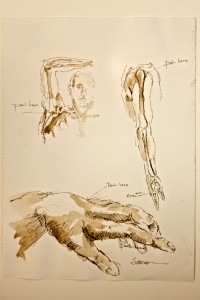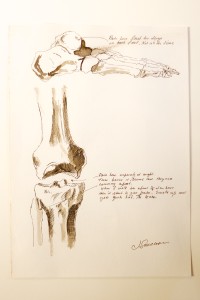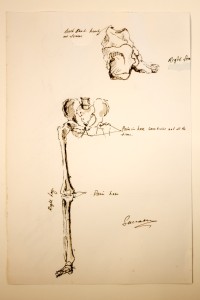I called Marco from the waiting room.
Everyone looked waxen under the fluorescent lights of Rheumatology Clinic. His olive skin looked grey. He rose like a grapevine on the trellis – thickset but gnarled through the seasons.
Marco helped his wife with her handbag and they walked together. Her gait was robust; his was antalgic and unhurried, though slower than he’d have liked.
In the consulting room we shared our introductions. I explained that I was aware of his medical history and asked “what are your biggest joint troubles today?”
Marco’s molten voice was rounded with a beautiful Italian accent and 80 years of life.
Apologising in fluent English Marco said that he didn’t speak English well and that it’s important to “talk the talk” of the doctors.
He looked down, reached into a shopping bag, and handed me three sheets of drawings.
I was stunned by beauty, utility, and clarity.
Brown ink outlined each picture, backfilled with camel watercolour. One image revealed the face of a younger man and the muscular shoulders of youth – his mind’s eye self-portrait.
Marco nodded to confirm that he had drawn them all.
Each drawing was anatomically correct and swelled from the parchment like parts of an amputee ghost. In some, his bones were bare. In others Marco had blended superficial features of skin with deeper structures of the appendicular skeleton.
A left hand floated on one page, like Adam’s in his Creation on the Sistine Chapel ceiling. Words – “Pain here” and “Here too” – were anchored by lines drawn to the hand, portraying metacarpophalangeal and proximal interphalangeal pain.
Figure 1. Annotated drawings of right shoulder, face, and left hand:
- “Pain here” [SHOULDER]
- “Pain here” [5th METACARPOPHALANGEAL JOINT]
- “Here too” [2nd METACARPOPHALANGEAL JOINT]
- “Pain here” [FINGER]
Six weeks earlier a rheumatologist had diagnosed Marco with recurrence of polymyalgia rheumatica, with shoulder and small joint features, and with a possible component of new onset rheumatoid arthritis. Recurrent carpal tunnel syndrome was diagnosed in his right hand.
On the other pages Marco had drawn his hips, knees, and feet, and annotated their aches with cursive writing.
“These bones it seems that they are coming apart. When I walk for about ¾ of an hour then it start to give pain. Swells up and gets quite hot. The knee.”
Figure 2. Annotated drawings of foot and knee:
- “Pain here especially at night.” [KNEE]
- “These bones it seems that they are comming (sic) apart. When I walk for about ¾ of an hour then it start (sic) to give pain. Swells up and gets quite hot. The knee.” [KNEE; TIBIOFIBULAR JOINT]
- “Pain here last for days on both feet. Not all the time” [TALUS]
Marco was seen in the hospital’s Orthopaedic Clinic for severe osteoarthritis of his knees.
A carpenter, who still bent those knees to work, Marco explained that he once did a Fine Arts degree to support his business. Beyond that expertise, his careful handling of the autographed pictures revealed an artist.
The edge of one page cut through the word “foot” at “foo” which perhaps reflected Marco’s life.
Born during the Great Depression he was of the frugal generation – practical, resourceful, industrious. I wondered if Marco had ever rationed paper as a luxury, each sheet precious and saved for handsome cabinet designs.
Perhaps as an artist, unwilling to share flaws, he had cropped a larger page of sketches.
Figure 3. Annotated drawings of right foot, pelvis and right lower limb:
- “Both feet hurt at times” [FOOT]
- “Pain in here sometimes not all the time” [HIP JOINTS BILATERALLY]
- “Right leg. Pain here” [FEMORAL HEAD, TIBIAL PLATEAU]
I was enthralled.
Marco’s eyes danced like bubbles from the surface of Prosecco – the muted pleasure of artistic pride.
Already he had offered his pictures to me three times as a gift.
Yet I had declined as it seemed too generous. I thanked Marco and encouraged him to keep bringing the drawings to appointments given their clinical value.
I completed the history.
Marco’s main concerns were steroid-related weight gain, although his arthralgia had improved.
As he talked I noticed subdued hand gestures. Given his Italian heritage, perhaps Marco suffered a cultural version of locked-in syndrome from the pain that restricted his upper limbs.
After completing the physical examination, I liaised with my registrar about Marco’s clinical plan. In a makeshift gallery behind the consulting suites I showed his artworks to the rheumatologists.
They advised that I could keep the pictures, and to take photocopies for the medical record. I made an extra copy either for me or for his art portfolio.
I returned to the clinic room. Marco’s wife, who had been silent, was keen to hear the consultants’ opinions of his drawings.
She beamed on learning that they were unanimously said to be “the most beautiful ever seen in clinic”, and particularly enjoyed by the Head Professor of Rheumatology.
Again Marco offered his pictures and this time I accepted with delight.
Smiling, he received his own copies as I explained his treatment changes and follow-up plan. We shook hands. Those aching hands created beauty and conveyed exceptional insights.
I watched as he left with his wife and wondered about their lives, leaving Italy to bring their charisma to Melbourne.
Two days later I framed the drawings – an exquisite medical document and gift. They hang in my home and evoke Marco’s grace, eloquence, and vitality.
* * *
Acknowledgements and Postscript
Marco, a pseudonym, has consented to the release of his artworks for the purposes of this article. See Figures 1, 2, and 3. Sincere thanks to the patient for his generosity and insights.
Thanks to Dr Thomas Lawson Haskell BMBS for his excellent photography of the drawings.
Correspondence: Dr Nancy Louisa Gwen Merridew BA BSc MBBS DTMH
Basic Physician Trainee, Launceston General Hospital
PO Box 1328, Launceston, Tasmania, Australia 7250


